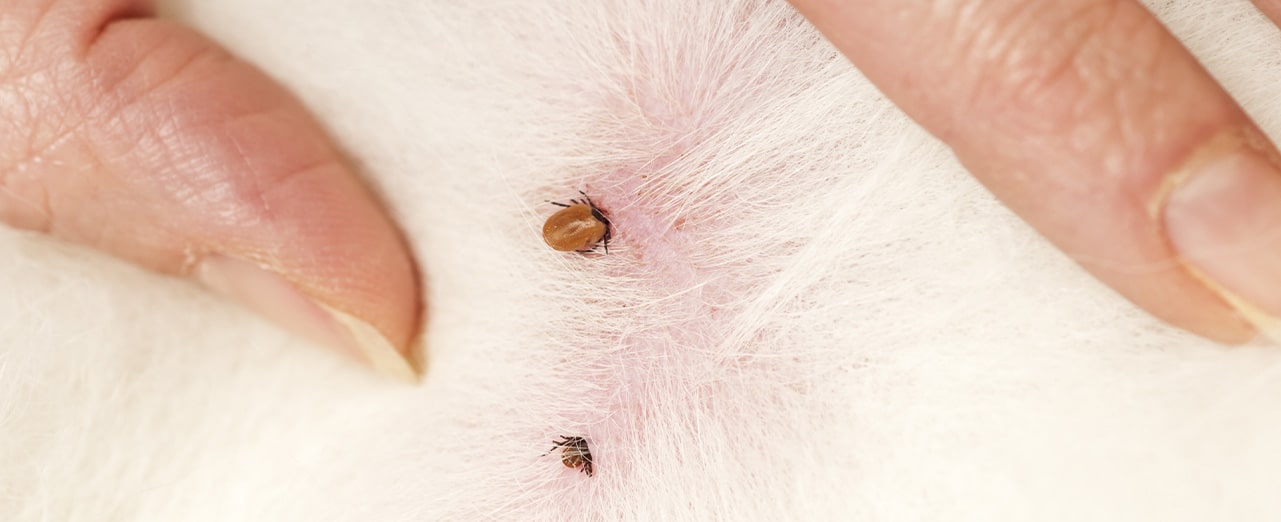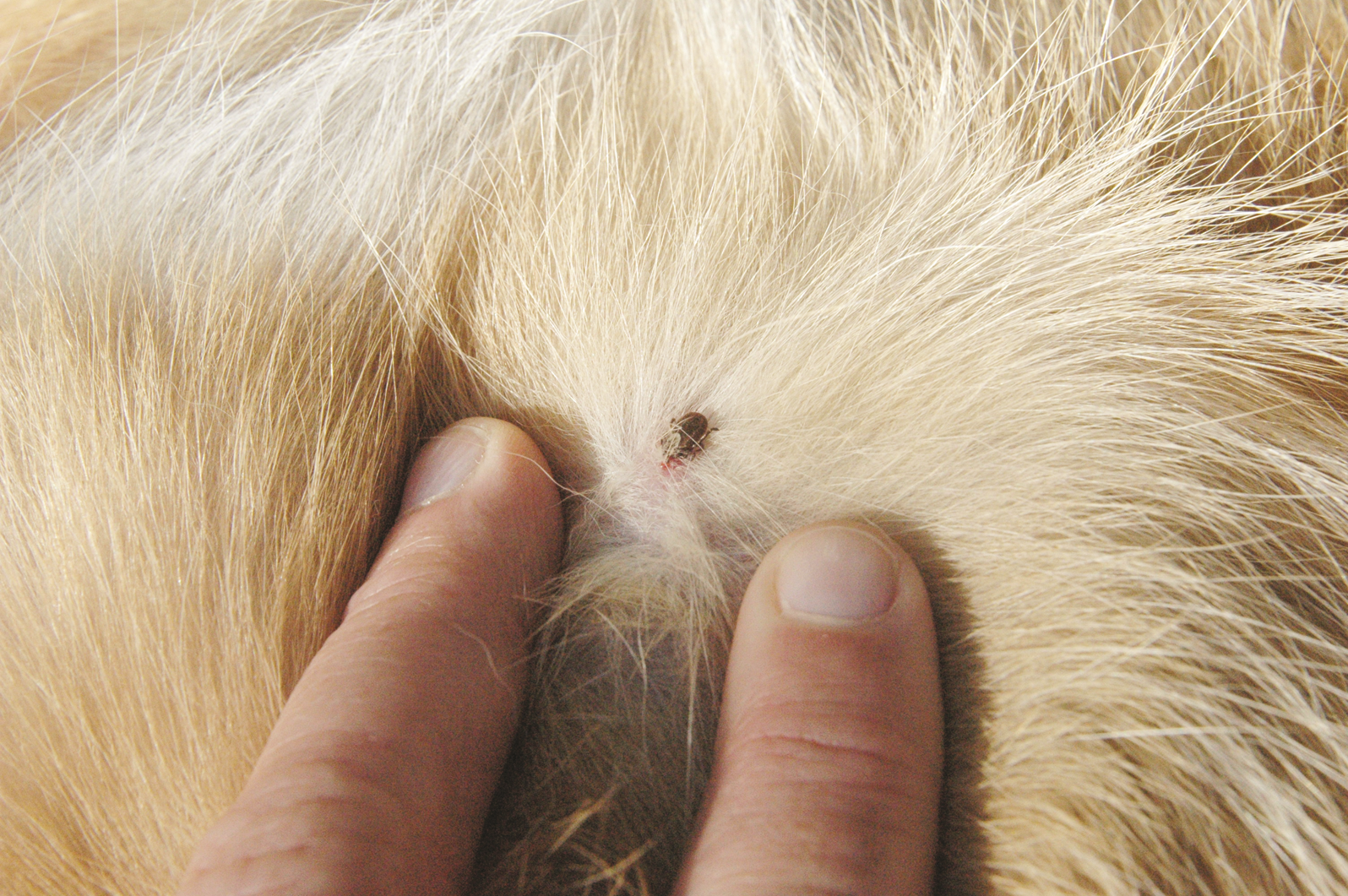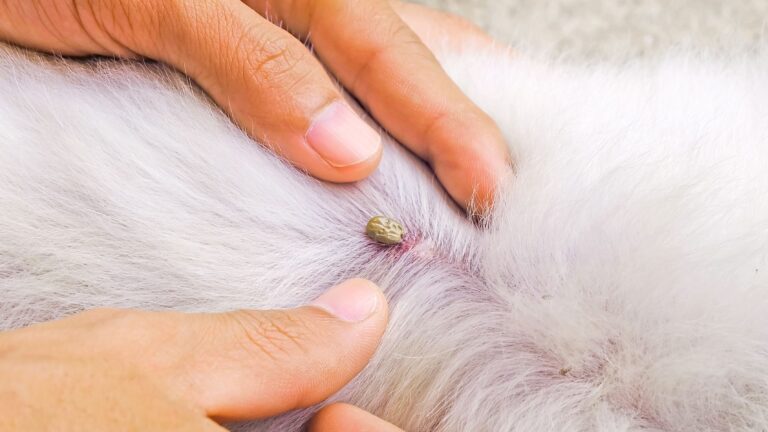A tick bite on a dog appears as a small, raised bump with a dark center. Tick bites in dogs can often go unnoticed, but it’s important to check for small, raised bumps with a dark center, indicating a possible tick bite.
If left untreated, tick bites can lead to serious health issues for your furry friend. Therefore, it is crucial for pet owners to be vigilant and regularly check their dogs for ticks. This article will discuss the appearance of tick bites in dogs, potential symptoms to look out for, and the necessary actions to take if your dog has been bitten by a tick.
By understanding the signs and risks associated with tick bites, you can effectively protect your dog from potential health complications.
Symptoms Of A Tick Bite In A Dog
Symptoms of a Tick Bite in a Dog
Visible Signs
When it comes to tick bites in dogs, there are some visible signs that you can look out for. Initially, you may notice a small, raised bump on your pet’s skin at the site of the bite. This bump could be red and slightly swollen. As time goes on, the bump may develop a crusty scab or a dark spot in the center.
In some cases, the tick may still be attached to your dog’s skin. Ticks are small, arachnid-like parasites that cling to the skin and feed on your pet’s blood. If you find a tick embedded in your dog’s skin, it is important to remove it carefully and completely to avoid any infections.
Behavioral Changes
Tick bites can also lead to behavioral changes in dogs. Your furry friend may become more restless or agitated than usual. They may excessively scratch or bite at the area where they have been bitten. This could be a sign of discomfort or irritation caused by the tick bite.
Additionally, some dogs may experience lethargy or fatigue. Tick bites can transmit various diseases to dogs, such as Lyme disease or Rocky Mountain spotted fever. These diseases can cause flu-like symptoms, including fatigue. If you notice your dog acting more tired than usual, it could be a cause for concern.
Another behavioral change to watch out for is loss of appetite. Dogs who have been bitten by ticks may lose interest in their food. This could be due to the discomfort caused by the tick bite or as a result of an underlying infection or illness.
In conclusion, being aware of the symptoms of a tick bite in dogs is essential for their well-being. By paying attention to visible signs and behavioral changes, you can promptly address any issues and seek appropriate veterinary care.

Credit: nexgard.com.au
Complications Of Tick Bites In Dogs
Tick bites in dogs can lead to various complications, making it crucial for pet owners to be vigilant and proactive in preventing and addressing tick infestations. Understanding the potential complications of tick bites in dogs, such as infections and allergic reactions, is essential for ensuring the health and well-being of our furry companions.
Infections
Tick bites can introduce dangerous pathogens into a dog’s bloodstream, leading to various infections. These may include Lyme disease, ehrlichiosis, anaplasmosis, and Rocky Mountain spotted fever. Infections can manifest with symptoms such as fever, lethargy, joint pain, and loss of appetite. Timely veterinary care is crucial to diagnose and treat these infections effectively.
Allergic Reactions
Some dogs may develop allergic reactions to tick saliva, leading to symptoms such as swelling, itching, and hives at the bite site. In severe cases, allergic reactions can escalate to anaphylaxis, causing breathing difficulties and potentially life-threatening complications. Prompt veterinary attention is necessary to manage allergic reactions and prevent further complications.
Preventing Tick Bites In Dogs
Dogs are at risk of tick bites, which can lead to various diseases. Preventing tick bites in dogs is crucial for their well-being. By taking the necessary precautions, pet owners can reduce the likelihood of their dogs being exposed to ticks. This not only ensures the dog’s health, but also contributes to a safer environment for the entire family. Implementing tick preventive measures is essential for safeguarding your pet’s health.
Tick Preventive Measures
Implementing tick preventive measures is essential for safeguarding your dog’s health. There are several effective strategies to help protect your furry friend from tick bites. These measures include:
- Using tick preventatives recommended by your veterinarian
- Regularly inspecting and grooming your dog for ticks
- Avoiding areas with high tick populations
- Maintaining a clean and tidy outdoor environment
- Using tick repellents when venturing into tick-prone areas
Regular Tick Checks
Regular tick checks are vital in preventing tick-borne diseases in dogs. Ensuring that your dog undergoes thorough tick inspections after outdoor activities can help identify and remove any ticks before they have a chance to transmit diseases. Focus on inspecting areas such as the head, neck, ears, and paws, as these are common hiding spots for ticks. Promptly removing any ticks you find is crucial for preventing potential health issues in your dog.
Removing A Tick From A Dog
Tick bites in dogs can appear as tiny, raised bumps with a dark dot in the center. These bites may cause itching, redness, and inflammation. Removing a tick promptly reduces the risk of tick-borne diseases.
Ticks are tiny, blood-sucking parasites that can transmit diseases to both humans and dogs. Spotting and promptly removing a tick from your furry friend is crucial to prevent any potential health complications. But how do you effectively remove a tick from a dog? Let’s explore some proper tick removal techniques and the tools you’ll need.
Proper Tick Removal Techniques
When it comes to removing a tick from a dog, it’s essential to follow proper techniques to minimize the risk of leaving any tick mouthparts embedded in your dog’s skin. Here are some steps to follow:
- Prepare: Start by wearing gloves to protect yourself from any potential diseases. Have a pair of tweezers or tick removal tool ready.
- Locate the tick: Carefully examine your dog’s coat, paying close attention to areas such as the neck, ears, and underbelly where ticks commonly attach themselves.
- Grab the tick: Using the tweezers or tick removal tool, grip the tick as close to the skin’s surface as possible.
- Pull steadily: With a gentle, but firm motion, pull the tick straight out. Avoid twisting, squeezing, or crushing the tick, as this can increase the risk of it regurgitating potentially harmful pathogens into your dog’s bloodstream.
- Dispose of the tick: Place the tick in a container filled with rubbing alcohol to ensure it is fully deceased. Properly disposing of the tick reduces the chances of it reattaching or spreading further.
- Clean the area: After removing the tick, clean the affected area with antiseptic solution or mild soap and water.
Tick Removal Tools
To safely and effectively remove ticks from your furry companion, it’s advisable to have the appropriate tools readily available. Here are some common tick removal tools:
| Tool | Description |
|---|---|
| Tweezers | A pair of fine-tipped tweezers can be used to grasp the tick firmly. Make sure the tweezers are clean and disinfected. |
| Tick Removal Tool | Tick removal tools, such as tick hooks or tick twisters, are designed specifically for safe tick removal. These tools allow you to grasp the tick without squeezing its body. |
| Tick Key | A tick key is a small, card-shaped device that can be used to remove ticks from your dog’s skin. It provides a simple and effective way to extract ticks at any life stage. |
Remember, the faster you remove a tick from your dog, the lower the risk of disease transmission. Regularly inspecting your furry friend for ticks, especially after spending time outdoors, is crucial in maintaining their health and well-being.
When To See A Veterinarian
If you suspect that your dog has been bitten by a tick, it is important to monitor their symptoms closely. While some tick bites may only cause mild irritation, others can lead to serious health concerns. In most cases, it is recommended to see a veterinarian if your dog experiences persistent symptoms or is at risk of contracting tick-borne diseases.
Persistent Symptoms
Tick bites in dogs can result in various symptoms, some of which may persist or worsen over time. It is crucial to be aware of these symptoms and seek veterinary care if any of them are present.
Some persistent symptoms of a tick bite in a dog include:
- Redness and inflammation: The area around the tick bite may become red, swollen, and inflamed.
- Itching and scratching: Your dog may constantly itch and scratch at the site of the bite.
- Lameness and joint stiffness: Tick-borne diseases can cause lameness and stiffness in the joints, making it difficult for your dog to move comfortably.
- Lethargy and loss of appetite: If your dog seems unusually tired or has a reduced appetite, it could be a sign of a tick-borne illness.
- Fever: Tick-borne diseases can sometimes lead to a persistent fever in dogs.
While these symptoms do not necessarily indicate a tick-borne disease, they could be warning signs that warrant a visit to the veterinarian for an evaluation and appropriate treatment.
Tick-borne Diseases
Ticks can transmit various diseases to dogs through their bites. Some of the most common tick-borne diseases include:
| Disease | Symptoms |
|---|---|
| Lyme disease | Joint pain, lameness, fever, loss of appetite, fatigue |
| Ehrlichiosis | Fever, loss of appetite, lethargy, nosebleeds, bruising |
| Anaplasmosis | Fever, lethargy, loss of appetite, joint pain, vomiting |
| Babesiosis | Fever, anemia, pale gums, weakness, weight loss |
If your dog shows symptoms consistent with any of these tick-borne diseases, it is crucial to seek veterinary care promptly. Early detection and treatment can significantly improve the outcome for your furry companion.

Credit: www.kingsdale.com

Credit: www.whole-dog-journal.com
Frequently Asked Questions On What Does A Tick Bite In A Dog Look Like
How Do I Know If My Dog Has Been Bitten By A Tick?
If you notice a small, red bump with a dark center on your dog’s skin, it may indicate a tick bite. Other signs can include irritation, swelling, and the presence of the tick itself. Be sure to consult your veterinarian to properly identify and treat the tick bite.
Is It Important To Remove A Tick From My Dog?
Yes, it is crucial to remove ticks from your dog as soon as possible. Ticks can transmit various diseases, including Lyme disease, to your dog. Use tweezers to grasp the tick close to the skin, gently pull it straight out, and clean the area with antiseptic.
How Should I Properly Remove A Tick From My Dog?
To remove a tick from your dog, use tweezers to grasp the tick as close to the skin as possible. Gently and slowly pull straight out, ensuring you remove the entire tick, including the head. Avoid twisting or jerking the tick to prevent leaving any parts behind.
Clean the area with antiseptic afterwards.
Can I Use Home Remedies To Remove A Tick From My Dog?
It is not recommended to use home remedies to remove a tick from your dog. These methods, such as heat or petroleum jelly, can cause the tick to release more saliva into your dog’s bloodstream, increasing the risk of disease transmission.
Stick to using tweezers to safely and effectively remove the tick.
Conclusion
Tick bites in dogs may not always be obvious, and it’s important for pet owners to know what to look for. From small red bumps to irritated skin and sometimes even a visible tick, recognizing the signs of a tick bite is crucial in ensuring your dog’s well-being.
Regularly checking for ticks and promptly removing them can help prevent tick-borne diseases and promote the overall health of your furry friend. Stay vigilant, stay informed, and keep your dog protected from these tiny but potentially harmful parasites.



